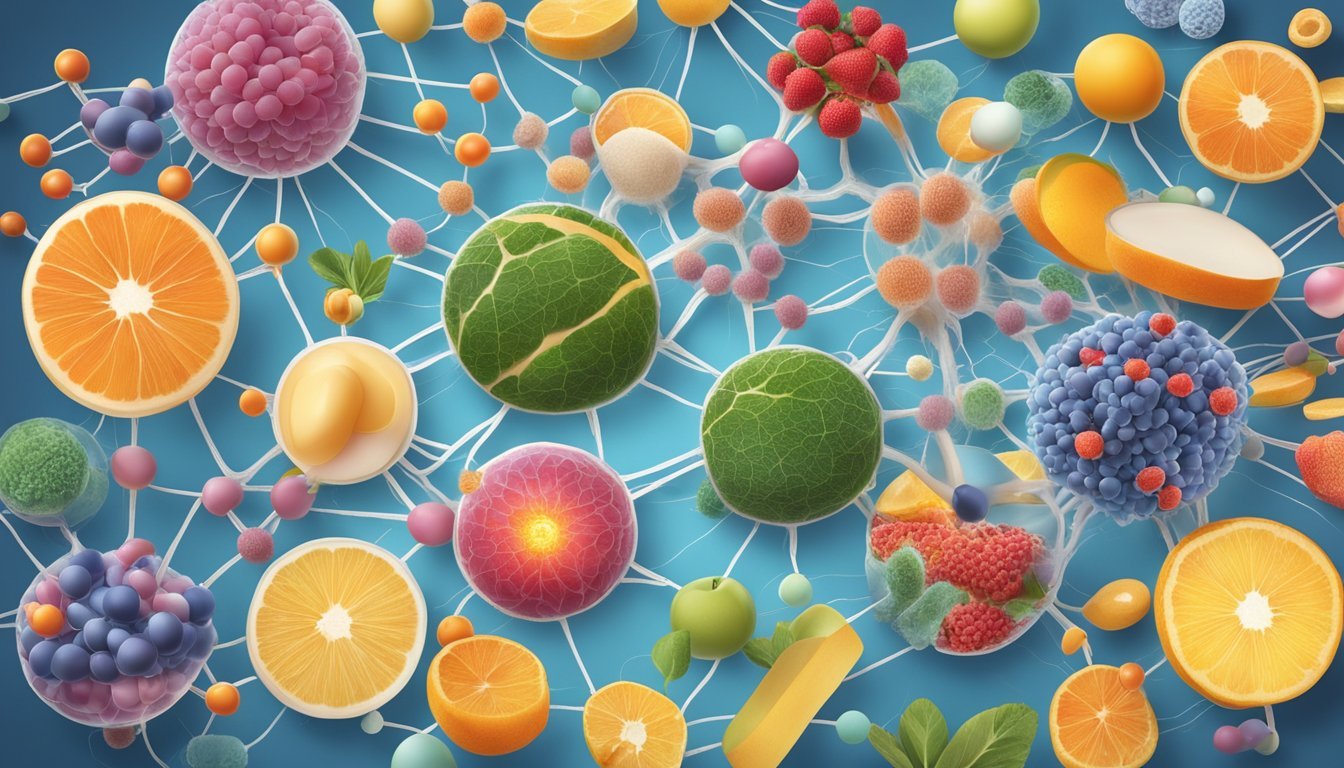The Role of Vitamins in Wound Healing and Scar Prevention
Nutritional Insights for Optimal Recovery
Wound healing is a complex biological process involving a series of coordinated events that include inflammation, tissue formation, and tissue remodeling. Vitamins play a crucial role in each of these stages, serving as cofactors for enzymes, antioxidants, and agents that modulate cell proliferation and differentiation. Adequate intake of specific vitamins is essential for optimal skin repair and for the prevention of excessive scarring, which can lead to functional and cosmetic impairments.
Among the vitamins, Vitamin C and Vitamin A are commonly recognized for their significant contribution to wound repair. Vitamin C, necessary for collagen synthesis, also serves as a potent antioxidant, protecting cells from damage by free radicals. Vitamin A, on the other hand, is critical for epithelial and bone tissue development, cellular differentiation, and immune response. The proper function of these vitamins is crucial for the maintenance of skin integrity and the enhancement of the healing process.
Recent research has also shed light on the potential benefits of other vitamins in wound care and scar management. Vitamins E and D have been studied for their anti-inflammatory properties and their role in wound modulation. Vitamin E has been shown to aid in moisturizing the wound environment and may help in preventing hypertrophic scarring and pruritis. Meanwhile, the role of Vitamin D in scar formation and its therapeutic potential in the pathogenesis and treatment of scarring are emerging areas of interest within the field of dermatology.
Understanding Wound Healing
Wound healing is an intricate process where the skin or any other body tissue repairs itself after injury. This section delves into the dynamics of wound healing, emphasizing the critical phases and the role of nutrition.
Phases of Wound Healing
Wound healing is categorized into four distinct phases:
Hemostasis: Immediately after an injury, vessels constrict and clotting begins to minimize bleeding. Platelets create a plug that is fortified by a fibrin mesh, effectively sealing the wound temporarily.
Inflammation: White blood cells rush to the wound to clear debris and bacteria, setting the stage for the subsequent stages of healing. This phase is characterized by redness, warmth, and swelling.
Proliferation: The focus shifts to regenerating tissue. Granulation tissue forms, and angiogenesis (creation of new blood vessels) is triggered to support new tissue growth. Collagen is deposited to strengthen the wound.
Remodeling: The final phase involves strengthening the collagen fibers and reorganizing them to increase the tensile strength of the skin. This stage can last up to several years.
Importance of Nutrition in Healing
Nutrition profoundly affects the healing process. Adequate intake of specific nutrients can facilitate quicker and more effective healing by influencing stages such as proliferation and remodeling. For instance:
Amino acids like arginine and glutamine are vital for collagen synthesis and immune function.
Vitamins play diverse roles; Vitamin C lowers the time to heal by protecting against oxidative stress, Vitamin E modulates cellular signaling important for healing wounds, including those infected with bacteria like MRSA.
A diet lacking in essential nutrients can delay the healing process, alter inflammatory responses, and compromise the formation of granulation tissue, thereby affecting the overall rate and success of wound healing.
Vitamins and Skin Health
Vitamins play pivotal roles in maintaining skin health through various mechanisms, including regeneration, collagen synthesis, and antioxidative defense mechanisms. These nutrients are critical for not only promoting effective wound healing but also in preventing the formation of unsightly scars.
Vitamin A and Skin Regeneration
Vitamin A is crucial for skin regeneration, as it promotes the replacement of old damaged skin with new skin cells. It is involved in re-epithelialization, an essential phase of wound healing where new epithelial cells form over a wound. Topical and systemic retinoids, derivatives of vitamin A, are commonly used to improve wound healing and minimize scarring.
Vitamin C: Collagen Synthesis and Inflammation
Vitamin C supports multiple aspects of the skin's healing process, most notably collagen synthesis. Collagen is the scaffolding protein crucial for skin strength and elasticity. Vitamin C is a co-factor for enzymes required in the hydroxylation of collagen molecules, promoting cross-linking and stabilization of collagen fibers. Furthermore, its anti-inflammatory effects help to modulate the immune response during the healing process.
Vitamin E: Antioxidant Properties
Vitamin E comprises a group of compounds, including tocopherols and tocotrienols, known for their potent antioxidant properties. This vitamin protects the skin from oxidative stress by neutralizing free radicals that can damage cells and hinder healing. By reinforcing the skin's barrier function, vitamin E plays a key role in maintaining skin health and assisting in wound healing and scar prevention.
Micronutrients in Wound Care
Micronutrients, including zinc and iron, play a pivotal role in the wound healing process due to their contribution to collagen synthesis, immune function, and antioxidant activity. These nutrients are essential for the various stages of wound repair, from inflammation to tissue remodeling.
Role of Zinc and Iron
Zinc is crucial for wound healing. It acts as a cofactor for more than 300 enzymes, including those involved in DNA replication, cell division, and protein synthesis—all vital to tissue repair and regeneration. Adequate zinc levels contribute to maintaining skin integrity, reducing the risk of infection, and promoting scar tissue formation. Zinc's antioxidant properties further strengthen its role in wound care, combating oxidative stress associated with injury.
Iron is primarily responsible for oxygen transport in the blood, a function essential for delivering oxygen to the wound site. Oxygen is critical for energy production and cellular metabolism, which, in turn, are vital for tissue repair. A deficiency in iron might impede this process, leading to poor healing outcomes.
Efficacy of Micronutrient Supplementation
Supplementing micronutrients like zinc and iron can be beneficial, especially in individuals with deficiencies that may hinder the healing process. Studies indicate that targeted micronutrient supplementation can improve wound healing rates, support the body's immune response to infection, and potentially minimize scarring. However, supplementation should be guided by healthcare professionals to prevent excessive intake, which could lead to adverse effects or interfere with the healing process. It is important to note that while micronutrients are supportive, they must be balanced with adequate macronutrient intake for optimal healing.
Inflammation and Immune Response
Inflammation is a fundamental aspect of the immune response in wound healing, and chronic wounds often present sustained inflammation. The role of vitamins in modulating the immune response is critical for effective wound repair and scar prevention.
Chronic Wounds and Inflammation
Chronic wounds are characterized by a protracted inflammatory phase, which can impede proper healing. In these wounds, leukocytes remain activated for an extended period, releasing proteases and free radicals that damage tissues and delay healing. This perpetual cycle of inflammation necessitates targeted therapeutic strategies to promote healing.
Leukocytes involved:
Neutrophils: Rapid responders, may cause collateral tissue damage.
Macrophages: Essential for phagocytosis and transition to the proliferative phase; their prolonged activation exacerbates chronic wounds.
Key Factors:
Prolonged leukocyte activity.
Excessive proteolytic environment.
Ongoing tissue damage.
Immunomodulation by Vitamins
Vitamins can play a pivotal role in immunomodulation during the wound healing process.
Vitamin C:
Function: Essential for collagen synthesis.
Benefits: Antioxidant properties and contribution to angiogenesis; promotes phagocyte function and reinforces the skin barrier.
Arginine:
Role: Precursor for nitric oxide and proline, instrumental for the inflammatory process and collagen synthesis.
Benefits: Supports immune cell function and helps to manage inflammation.
Glutamine:
Role: Sustains cell proliferation and energy source during cellular stress.
Benefits: Enhances leukocyte activity and has anti-inflammatory effects, benefiting the healing of chronic wounds.
Critical Points:
Anti-inflammatory properties aid in resolving prolonged inflammation.
Support of key immune cell functions.
Vitamins contribute to biochemical pathways crucial for wound healing.
Vitamins in Scar Prevention
Vitamins play a pivotal role in the body's ability to minimize scarring following tissue injury. They support crucial repair mechanisms and contribute to the regulatory processes of scar formation.
Scar Formation and Extracellular Matrix
Scar tissue is the body's natural response to wound healing, where the extracellular matrix (ECM) plays a crucial role. The ECM is a complex network of proteins, including fibronectin, that facilitate the structural support necessary for tissue regeneration. The proper alignment and remodeling of these proteins are essential in preventing abnormal scar formation. Vitamin C is pivotal in this phase, as it is a co-factor for the enzymes involved in synthesizing collagen, a major component of the ECM, thus promoting a well-organized, less noticeable scar.
Vitamin A and its derivatives, commonly known as retinoids, have been shown to regulate gene expression during the wound healing process. They help in modulating inflammation and encouraging the orderly remodeling of the ECM, which can reduce the incidence of hypertrophic scars and keloids.
Improving Cosmetic Appearance
The cosmetic appearance of scars is influenced by the balance of processes that govern tissue repair and regeneration. Vitamin E is often cited in cosmetic use, having anti-inflammatory properties and interacting with cellular membranes to maintain stability.
Although some studies suggest that Vitamin E can alleviate pruritis (itchiness) associated with healing wounds, its efficacy in scar improvement is contested. Certain sources highlight its role in preventing hypertrophic scarring, but a lack of consistent clinical evidence necessitates cautious application.
Vitamin D has shown potential in wound healing phases. Its anti-inflammatory properties can influence the healing process, which might affect the development of scars, although direct benefits in scar prevention are yet to be reliably confirmed.
Considering vitamins as part of scar prevention requires an understanding of the delicate healing processes and the limitations of current research. Vitamins can aid in ensuring a healthy ECM formation and potentially improve the cosmetic appearance of scars, but their effectiveness varies, and more research is needed for conclusive guidance.
Novel Therapies and Emerging Research
Recent advancements in the realm of wound healing and scar prevention have been shaped by rigorous scientific exploration. Systematic reviews and clinical trials, sourced from databases like PubMed and Medline, have showcased the potential of topical administration and advanced therapeutic interventions in this field.
Topical Administration
Topical administration of vitamins plays a pivotal role in enhancing wound healing and mitigating scar formation. This localized approach allows for higher concentrations of vitamins directly at the wound site, fostering an environment conducive to tissue repair and reducing the likelihood of hypertrophic scarring and keloid formation. Prospective studies have been assessing various formulations, with a specific focus on their ability to improve the efficacy of vitamins in the context of plastic surgery and scar treatment.
Systematic Reviews and Clinical Trials
Systematic reviews, including those from Cochrane databases, have synthesized data from numerous clinical trials to evaluate the effectiveness of novel vitamin-infused therapies for wound care. These reviews often highlight the importance of well-designed clinical trials in establishing treatment protocols. Clinical trials, especially those that are prospective in nature, scrutinize the scope of vitamin therapies in the prevention and treatment of scars, including hypertrophic and keloid scars, thereby guiding evidence-based practices in wound management.
Clinical Considerations in Wound Care
Effective wound care encompasses both the appropriate medical treatments and the nutritional support that are essential for repair and regeneration of tissues. The role of vitamins and overall nutrition is critical in the wound healing process.
Assessment of Nutritional Status
Healthcare professionals evaluate a patient's nutritional status as a foundational step in wound care. Key factors such as protein levels, caloric intake, and the presence of vitamins and minerals are assessed. Malnutrition, especially protein deficiency, can severely delay wound healing. Thus, a careful analysis of dietary intake is crucial.
Protein: Sufficient protein is necessary for cell repair and growth.
Vitamin A: Necessary for epithelial and bone tissue growth, immune system regulation, and red blood cell production.
Vitamin C: Important for collagen synthesis, capillary formation, and immune function.
Zinc: Vital for protein synthesis and cell division.
A multidisciplinary approach is advisable, involving nutritionists, physicians, and wound care specialists to accurately assess and address the patient's dietary needs.
Integrative Approaches to Wound Management
An integrative approach to wound management highlights the importance of a comprehensive plan that includes both medical and nutritional interventions. Dietary vitamin A, for instance, is integral in wound healing due to its role in stimulating epithelial turnover and collagen synthesis. Meanwhile, malnutrition can impede wound healing, making dietary assessment and intervention key components of patient care.
Patients may receive:
Topical treatments: Including application of vitamins like A and E directly to the wound.
Dietary supplementation: To address deficiencies that can hinder healing.
High-protein diets: To support tissue repair.
Clinical practice must balance these treatments with the individual patient's needs, continually reassessing and tailoring strategies to optimize wound healing and minimize scarring.
Treatment Efficacies and Adverse Reactions
In the context of wound healing and scar prevention, the use of vitamins has shown efficacy in both monotherapy and combination therapy, though it is not without potential adverse reactions. Understanding the balance between treatment outcomes and managing side effects is crucial for optimal patient care.
Monotherapy Versus Combination Therapy
Monotherapy, or the use of a single vitamin treatment, has shown its own benefits in wound healing and scar prevention. For instance, topical Vitamin E application can help in moderating scar formation. On the other hand, combination therapy, typically involving a blend of vitamins such as Vitamin C and Vitamin A derivatives like retinols, retinals, and retinoic acids, may enhance the healing process and scar appearance more significantly than monotherapy due to their complementary mechanisms of action.
Vitamin E: Aids in reducing the appearance of scars when applied topically.
Vitamin C: Essential for collagen synthesis and wound repair.
Retinoids: Promote cellular turnover and can attenuate scarring.
Managing Side Effects
While the benefits of vitamin therapy in wound healing are established, certain side effects must be managed to ensure patient safety and comfort. Adverse events like contact dermatitis, itching (pruritis), and irritation can occur, particularly with retinoid use. It's crucial to monitor patients for signs of skin reactions and adjust treatment protocols accordingly.
Contact Dermatitis: May result from topical applications, requiring cessation of treatment or switch to alternative therapies.
Pruritis: Often managed with antihistamines or corticosteroids.
Retinoids: Common side effects include dryness and irritation; initiating treatment with lower concentrations can help mitigate these effects.
Practical Implications in Plastic Surgery
In plastic surgery, the management of scars and adherence to professional guidelines significantly affects patient outcomes. Vitamins, particularly in their role in healing and prevention, are key to these processes.
Scar Management Strategies
Plastic surgeons often implement targeted strategies to minimize scar formation post-surgery. Recognizing that vitamins play crucial roles in tissue repair and scar prevention, they might advise patients on specific supplementation regimens. Vitamin E, for example, despite its potential benefits for surgical wound healing, is generally recommended to be discontinued two weeks prior to surgery due to an associated risk of increased bleeding. In contrast, Vitamin K is acknowledged for aiding early wound healing, principally due to its essential function in blood clotting.
For comprehensive scar management, a combination of therapeutic approaches may be employed including combination therapy (utilizing multiple treatment modalities) and monotherapy (using a single treatment method), each chosen based on the specific needs of the patient and the type of surgical procedure.
The Role of the American Society of Plastic Surgeons
The American Society of Plastic Surgeons (ASPS) provides a set of guiding principles for its members, ensuring that best practices in scar management are followed. The ASPS endorses evidence-based approaches and underscores the significance of postoperative care in determining the success of plastic surgery outcomes. They encourage their member surgeons to stay informed about the latest research in scar treatment, including the impact of nutrition and vitamin supplementation on wound healing, to offer the most effective care for their patients.
Biochemical Pathways of Vitamins
Vitamins play a crucial role in the regulation of various biochemical pathways critical for wound healing and scar prevention. They exert their effects by modulating reactive oxygen species, facilitating signaling pathways, and supporting cellular processes essential for tissue repair.
Reactive Oxygen Species and Antioxidants
Reactive oxygen species (ROS) are byproducts of metabolism that can cause cellular damage, impeding the wound healing process. Vitamins like Vitamin C and E serve as antioxidants, mitigating the harmful effects of ROS through their scavenging activity. Specifically, Vitamin C reduces oxidative stress, protecting against damage and aiding in the restoration of the skin's barrier function. Vitamin E, with its antioxidant properties, contributes to maintaining cell membrane integrity, especially in keratinocytes and fibroblasts which are pivotal for skin repair.
Vitamin C:
Neutralizes ROS
Supports collagen synthesis in fibroblasts
Vitamin E:
Protects cell membranes from oxidative damage
May modulate gene expression related to wound repair
Signaling Pathways and Cellular Processes
Vitamins engage in signaling pathways and influence cellular processes such as growth, differentiation, apoptosis, and angiogenesis— the formation of new blood vessels. Vitamin C is known to stimulate fibroblast proliferation, which enhances the tensile strength of the healing wound. Additionally, Vitamin C plays a role in the hydroxylation of proline and lysine, amino acids necessary for stabilizing the triple helix structure of collagen.
Vitamin E impacts cellular signaling and gene expression, which can affect wound healing, especially in wounds challenged by bacterial contamination, such as infections with methicillin-resistant Staphylococcus aureus (MRSA). It may alter the production of growth factors necessary for wound healing, promoting keratinocyte growth and supporting the development of blood vessels within the repair site.
Vitamin C:
Enhances fibroblast growth
Critical for collagen maturation and angiogenesis
Vitamin E:
May influence growth factor signaling
Supports the maintenance and recovery of keratinocytes and fibroblasts
Special Populations and Wound Healing
Certain populations, such as children and the elderly, require special attention when it comes to wound healing due to their unique physiological conditions. Malnutrition is a significant concern that can impede recovery in any patient population.
Pediatric and Geriatric Considerations
Children have a higher metabolic rate and a more robust inflammatory response compared to adults, which can lead to a quicker initiation of the wound healing process. However, their dietary needs for vitamins and other nutrients essential for tissue repair are proportionally higher—making balanced nutrition critical for effective wound healing.
In contrast, the elderly population often experiences a natural decline in cellular function and a slower regenerative process. Age-related changes in skin and underlying tissues, along with the potential for reduced dietary intake, make proper nutrition and vitamin supplementation vital to support the slower wound healing rates commonly seen in this demographic.
Wound Care in Malnourished Populations
Malnutrition directly affects wound healing by impeding the body's ability to form new tissues and by weakening immune responses. Vitamin deficiencies, particularly those of vitamins C and zinc, can result in delayed wound healing and poor scar formation.
Adequate dietary management is essential for malnourished populations, including both macro and micronutrients. It is crucial for healthcare providers to identify signs of malnutrition and address any dietary deficiencies. Implementing nutritional screenings and providing education on nutrient-rich diets can be key steps in improving wound care outcomes in these populations.
Supportive Treatments in Wound Healing
Supportive treatments play a pivotal role in wound healing by providing the essential components for tissue repair and scar prevention. These treatments can include a variety of approaches, from nutritional supplements that provide necessary micronutrients to advanced biomaterials designed to facilitate the healing process.
Nutritional Supplements
Nutritional supplements aim to provide the body with the micronutrients required for effective wound healing. Two key vitamins have been identified as particularly important:
Vitamin C: This vitamin is essential for collagen synthesis, which is critical for the structural integrity of new tissue. Studies have shown that vitamin C also supports the function of endogenous antioxidants, which protect cells from damage by free radicals.
Vitamin E: Known for its antioxidant properties, vitamin E helps protect the cell membrane from oxidative stress, thus aiding in the maintenance and repair of damaged tissue. Evidence suggests that vitamin E supplementation can modulate gene expression related to wound healing.
Advanced Biomaterials
Biomaterials such as chitosan have gained attention in the field of wound management. Chitosan, a natural biopolymer, has unique properties that contribute to wound healing:
Intrinsic antimicrobial activity: Chitosan can help reduce the risk of infection at the wound site.
Enhancement of tissue regeneration: By providing a scaffold, chitosan supports the overall structural integrity of regenerating tissue.
These advanced biomaterials are often used in conjunction with traditional wound care practices to accelerate healing and improve outcomes.
The Role of Diet in Wound Healing
The healing of wounds is a complex process that can be significantly aided by proper nutrition, specifically the intake of certain vitamins that play critical roles in tissue repair and immune function.
Dietary Guidelines
Vitamins B and D are crucial to the wound healing process. B vitamins, especially vitamin B1 (thiamine), B6 (pyridoxine), and B12 (cobalamin), support cellular function and play a role in the synthesis of new cells. They aid in energy metabolism, which is necessary for the repair processes. Particularly, vitamin B1 assists in proper coagulation, an essential early phase of wound healing.
Vitamin D is not only paramount for bone health but also modulates inflammation and the immune response during the healing process. A diet adequate in these vitamins is important to support these functions.
Dietary Vitamin A affects wound healing as well. The body utilizes vitamin A to maintain and repair epithelial tissue. With sufficient Vitamin A, enterocytes produce chylomicrons, which transport retinol-binding protein necessary for systemic distribution of retinol, a form of vitamin A. This is important for the synthesis of new tissue and immune function.
Evaluating Diets for Optimal Wound Recovery
To ensure optimal wound healing, one should evaluate their diet for inclusion of:
Vitamins B and D: Include sources such as eggs, lean meats, fortified milk and cereals, and fish.
Vitamin A: Rich dietary sources include liver, fish oil, green leafy vegetables, and yellow-orange fruits and vegetables.
For wound recovery, a comprehensive dietary approach includes assessing macronutrient intake alongside micronutrients, ensuring protein adequacy for the repair of damaged tissues, and sufficient calories to meet the metabolic demands of healing.
Cellular and Molecular Mechanisms of Healing
Wound healing is an intricate process involving cellular proliferation, tissue remodeling, and re-epithelialization, crucially carried out by keratinocytes, fibroblasts, and various growth factors.
Wound Contraction and Epithelialization
In the initial phases of wound healing, fibroblasts play a pivotal role in tissue development. They synthesize extracellular matrix components that are essential for the strength and structure of the new tissue. This cellular activity leads to wound contraction, where the edges of the wound are pulled together to reduce the area that requires healing.
Keratinocytes then migrate across the wound bed, a process described as re-epithelialization. Re-epithelialization is necessary for restoring the barrier function of the skin. These cells proliferate and differentiate to form new epidermal layers over the granulation tissue, effectively sealing the wound and providing initial strength to the repaired area.
Understanding Growth Factors and Re-epithelialization
Growth factors are proteins that regulate cellular processes such as proliferation and differentiation. They are vital in wound healing, acting as signaling molecules that guide the repair process:
Epidermal growth factor (EGF) aids keratinocyte migration and granulation tissue formation.
Transforming growth factor-beta (TGF-β) modulates inflammation, promotes fibroblast proliferation, and influences scar formation.
Platelet-derived growth factor (PDGF) attracts cells to the wound site, stimulates fibroblast growth, and promotes the formation of new blood vessels.
During re-epithelialization, growth factors also enhance the activity of enzymes that remodel the extracellular matrix, facilitating the migration and stabilization of keratinocytes. The exact orchestration of these factors is critical to effective wound healing and scar prevention, ensuring proper tissue structure and function is restored.
Vitamin-Related Health Beyond Wound Care
Beyond their critical role in wound healing and scar prevention, vitamins are integral to various physiological functions. This section explores the specific roles of vitamins in vision and reproduction, as well as their impacts on immunity and growth.
Impacts on Vision and Reproduction
Vision: Vitamins play significant roles in maintaining visual health. Vitamin A, for instance, is essential for the proper functioning of the retina, and deficiencies can lead to conditions such as night blindness. The body uses retinoids, which include forms of vitamin A, to maintain the health of epithelial tissues, including those in the eyes. Vitamin A operates through nuclear retinoic acid receptors and retinoid X receptors, integral for embryological development and cellular differentiation, influencing vision clarity and overall eye health.
Embryological Development: Adequate vitamin A is crucial during fetal development, as it influences embryonic growth, including the proper development of the visual system.
Reproduction: Vitamins not only impact visual health but are also involved in reproductive health. For example, vitamin E acts as an antioxidant, contributing to the protection of cell membranes from oxidative stress, which is important for reproductive processes and immunity.
Cellular Differentiation: In reproduction, vitamins are involved in cellular differentiation processes, ensuring that reproductive cells develop correctly for successful conception.
Impacts on Immunity and Growth
Immunity: Vitamins are indispensable for immune system function. Vitamin C, for instance, enhances the body's ability to defend against infections and diseases. It supports various cellular functions of both the innate and adaptive immune systems. Vitamin A also plays a role in immunity by maintaining the integrity of mucosal surfaces, acting as a first line of defense against infections.
Growth: Adequate intake of vitamins is associated with proper physical growth and development. Vitamin D is essential for bone growth and the regulation of calcium metabolism. It helps in the absorption of calcium and phosphorus, which are crucial for the development of a strong skeletal structure.
These vitamins and their complex interactions demonstrate their indispensable nature in critical bodily functions extending well beyond wound care to vision, reproduction, immune response, and overall growth.










